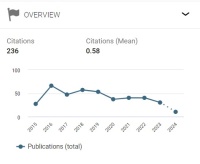Evaluasi Model Machine Learning Klasifikasi Gerak Tangan Untuk Sistem Kontrol Prototipe Prostesis Tangan
Abstract
Obstacles in the form of loss of function of body parts will cause difficulty in carrying out normal activities. In the application of electromyography (EMG) and electroencephalography (EEG) sensors that are not good at compensating for various kinds of human physical conditions, force sensing resistor (FSR) sensors can be an alternative to EMG and EEG in hand prostheses. In planning the neural network model, the data needed for the actual output is only in the form of hand gestures for post-amputation non-patients. Long Short Term Memory (LSTM) is used because it can handle data processing in the long run which is one of the conditions that arise in sequential data processing. The resulting evaluation metrics are in the form of accuracy values in training data with epoch 200 and accuracy in data testing. The first result with no dropout variation shows the accuracy value in training is 0,9449 and the accuracy in testing is 0,961 with the loss value in training is 0,1284 and the loss in testing is 0,0717. The second result with dropout variations shows the accuracy value in training is 0,9699 and accuracy in testing is 0,9688 with a loss value in training is 0,0803 and loss in testing is 0,1061. the metrics accuracy evaluation generated on the dataset has exceeded the value of 0,9. This indicates that the model has run well for the classification of 11 movements.
Keyword — Control System; machine learning; moving arm; prostesis arm.
Downloads
References
[2] Shin, A. Y., Spinner, R. J., Steinmann, S. P., & Bishop, A. T., “Adult traumatic brachial plexus injuries,” The Journal of the American Academy of Orthopaedic Surgeons, 13(6), 382–396, 2005. doi: 10.5435/00124635-200510000-00003.
[3] Vujaklija, I., Farina, D., & Aszmann, O. C., “New developments in prosthetic arm systems,” Orthopedic Research and Reviews, 8, 31–39, 2016. doi: 10.2147/ORR.S71468.
[4] Satam, I. A., “Review Studying of the Latest Development of Prosthetic Limbs Technologies,” 2021.
[5] Hutchinson, D. T., “The Quest of Bionic Arms,” Journal of the American Academy of Orthopaedic Surgeons 22(6):p 346-351, June 2014. doi: 10.5435/JAAOS-22-06-346.
[6] Naim, A. M., Wickramasinghe, K., De Silva, A., Perera, M. V., Lalitharatne, T. D., & Kappel, S. L., “Low-cost Active Dry-Contact Surface EMG Sensor for Bionic Arms,” Conference Proceedings - IEEE International Conference on Systems, Man and Cybernetics, 3327–3332, 2020. doi: 10.1109/SMC42975.2020.9283285
[7] Li, N., Yang, D., Jiang, L. et al., “Combined Use of FSR Sensor Array and SVM Classifier for Finger Motion Recognition Based on Pressure Distribution Map”, J Bionic Eng 9, 39–47, 2012. doi: 10.1016/S1672-6529(11)60095-4
[8] Pahlevi, A., Syauqy, D., & Rahayudi, B., “Implementasi Gripper Pada End Effector Robot Untuk Memegang Telur Ayam Dengan Sensor FSR (Force Sensitive Resistor),” Jurnal Pengembangan Teknologi Informasi dan Ilmu Komputer, Vol. 2, No. 12, p. 6761-6770, 2018. ISSN 2548-964X.
[9] C. M. Bishop, “Neural networks and their applications,” Review of Scientific Instruments 65, 1803, 1994. doi: 10.1063/1.1144830
[10] Mishra, D., Naik, B., Sahoo, R.M., Nayak, J., “Deep Recurrent Neural Network (Deep-RNN) for Classification of Nonlinear Data,” Advances in Intelligent Systems and Computing, vol 1120, 2020. doi: 10.1007/978-981-15-2449-3_17
[11] Lely Meilina, I Nyoman Satya Kumara, I Nyoman Setiawan, “Literature Review Klasifikasi Data Menggunakan Metode Cosine Similarity dan Artificial Neural Network,” Majalah Ilmiah Teknologi Elektro, v. 20, n. 2, p. 307-314, dec. 2021. ISSN 2503-2372.
[12] I. F. Rozi, V. N. Wijayaningrum och N. Khozin, “Klasifikasi Teks Laporan Masyarakat Pada Situs Lapor! Menggunakan Reccurent Neural Network,” Jurnal Sistem Informasi, Vol. 1, No.3, 2020.
[13] Lugaresi, C., Tang, J., Nash, H., McClanahan, C., Uboweja, E., Hays, M., Zhang, F., Chang, C.-L., Yong, M. G., Lee, J., Chang, W.-T., Hua, W., Georg, M., & Grundmann, M., “MediaPipe: A Framework for Building Perception Pipelines,” 2019. [Online]. Available: http://arxiv.org/abs/1906.08172
[14] Barron, O., Raison, M., Gaudet, G., & Achiche, S., “Recurrent Neural Network for electromyographic gesture recognition in transhumeral amputees,” Applied Soft Computing Journal, 96, 106616, 2020. doi: 10.1016/j.asoc.2020.106616
[15] S. Hochreiter, J. Schmidhuber, “LSTM can solve hard long time lag problems,” Advances in Neural Information Processing Systems 9, 1996.
[16] Diederik Kingma and Jimmy Ba., “Adam: A method for stochastic optimization”, 2014. doi: 10.48550/arXiv.1412.6980
[17] Ida Bagus Leo Mahadya Suta, Made Sudarma, I Nyoman Satya Kumara, “Brain Tumor Segmentation Based on Magnetic Resonance Imaging Images Using the U-NET Method,” Majalah Ilmiah Teknologi Elektro, vol. 19, no. 2, p. 151-156, dec. 2020. ISSN 2503-2372.
[18] de Boer, PT., Kroese, D.P., Mannor, S., “A Tutorial on the Cross-Entropy Method,” Ann Oper Res 134, 19–67, 2005. doi: 10.1007/s10479-005-5724-z
[19] Hinton, G. E., Srivastava, N., Krizhevsky, A., Sutskever, I., & Salakhutdinov, R. R., “Improving neural networks by preventing co-adaptation of feature detectors,” 2012. arXiv preprint arXiv:1207.0580.
[20] A. Gunawardana, G. Shani, “A Survey of Accuracy Evaluation Metrics of Recommendation Tasks,” Journal of Machine Learning Research 10, 2935-2962, 2009.


This work is licensed under a Creative Commons Attribution-NonCommercial-NoDerivatives 4.0 International License.

This work is licensed under a Creative Commons Attribution 4.0 International License




